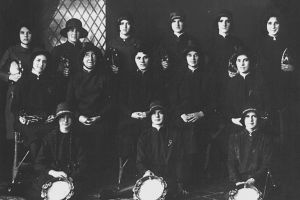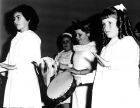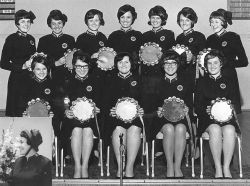The Timbrels
To understand the story of the playing of timbrels (which differ in many ways to the more commonly known 'tambourine') at Hurstville Salvation Army, we must first go back to the origins of timbrel-playing by Salvationists at the very beginning.
The First Timbrellist

The history of the Timbrel Brigade in The Salvation Army is an interesting one, though there are differing stories as to the origins, or at least, the identity of the first Timbrellist. Captain Charles Rothwell in England claimed (in the mid 1800s) that his wife was the first to use a timbrel. He found a tambourine in a pawnbroker's shop and lost no time in buying it. Mrs Rothwell forthwith played it in the processions, which "filled the devil with disgust' the newspapers with comment, the barracks with people, and helped sinners into the fountain", reported a news article at the time.
Another story of the origins of timbrel playing with the Salvation Army is a most fascinating one. Lizzie was a cashier at a cheap little theatre near first Corps in London. She was a rough Cockney girl, and anyone who tried to sneak into the theatre free of charge would get a rough handling by Lizzie. One thing fascinated her though: the tambourine-playing troupe of gypsies who performed nightly inside the theatre.
One night Lizzie met some Salvationists marching out of Hyde Park. One of the soldiers was helping a drunken woman along, and Lizzie, curious as ever, followed the strange procession to the hall. It wasn't long before she was truly converted, and became a Soldier, although for this her family turned her out of home. The Captain had heard of Lizzie's accomplishments and asked her if she would join the drummer with a tambourine. She was delighted, and made her musical debut in a children's meeting. Soon Londoners became accustomed to the sight of a dark, vivacious woman marching at the Army procession, and jingling a tambourine as if her life depended upon it. 'Tambourine Lizzie', as they called her, became an Officer and married Captain Cheeseman in Aberdeen, Scotland. The conservative Scots were dismayed, then delighted by her tambourine solo - at her own wedding (excerpts from The War Cry, New York).
The use of the timbrel, whoever was first to use it, spread very quickly. In The War Cry of 7 October 1882, it was noted that 1,600 timbrels had been sold in six weeks. The Small Heath Corps of Birmingham England, did not have a Band or Songster Brigade, so someone suggested a Timbrel Band, but when the instruments from Headquarters arrived they were not suitable for band work. William Goddard then designed a timbrel in 1893. The timbrel was first used at Easter in 1894.
The timbrel which is used today hasn't changed significantly since the original design by William Goddard.
The Hurstville Brigade

The origins of the Hurstville Timbrel Brigade are as illusive as the beginnings of the Timbrel Brigade worldwide. It is not known who introduced this medium of praise and worship at Hurstville, or exactly when. The photograph shows that the Timbrel Brigade was alive and well in the 1920s and 1930s, and includes Bonnie Huggett, Eva Veal, Hilda Miller and Mrs Hodge. The Brigade increased in proficiency and standard over the following decades, until in the 1950s it became known in Salvation Army circles as one of the best in Sydney.

Many girls started playing timbrels during meetings as children, and continued on through the 'ranks' to Senior Timbrels.
The Hurstville Timbrel Brigade has been involved in numerous 'massed timbrel' items, including the Sydney Metropolitan Divisional Band Parade held at Arlington Oval, Dulwich Hill on 16 February 1957, where 150 Timbrellists joined forces to present the 'marches' Army of Immanuel, Keep Singing and Montreal Citadel.
A Timbrel Festival was held at Hurstville on 15 August 1964, with Brigades from Miranda, Burwood, Rockdale, Campsie and Hurstville amongst those who participated. This was a venture in faith for the Hurstville Brigade, and such was its success that the Hurstville Citadel was far too small for the crowd.
The Hurstville Timbrel Brigade have accompanied the Hurstville Band on many of their trips. On the October long weekend in 1964 they visited Coffs Harbour with the Band, travelling by chartered bus. Later that month, the Timbrels and Band participated in the annual Sydney Waratah Festival.
The Sydney Town Hall saw a near capacity crowd for the 1971 Congress Festival of Praise. It was reported that "Hurstville Timbrellists are, without a doubt, the best Brigade in Sydney at present. Their display to Universal Message was well drilled and precise. The beats accentuated the rhythms in the march to a high degree of proficiency."
Red Shield
 On more than one occasion Hurstville Timbrels have had the privilege of a standing ovation for their performances. In the late 1960s 'Red Shield' became a "classic" timbrel march, created by Janette Smart and which still lives on in the memories of those who played it.
On more than one occasion Hurstville Timbrels have had the privilege of a standing ovation for their performances. In the late 1960s 'Red Shield' became a "classic" timbrel march, created by Janette Smart and which still lives on in the memories of those who played it.
Easter 1978 saw the Brigade travel north to Taree with the Band. The Timbrellists and Band set the mood for what was to be an enjoyable Saturday evening of music. Besides the talented timbrel displays, Timbrellist Jenny Wemyss presented an excellent piano solo, and Timbrellist Meredith Parkinson's elocution was of a very high standard, contributing to the wide variety of the programme.
In the early 1980s the Timbrel Brigade ventured into some diverse ways of sharing the Light, including participating in a Chinese/Australian friendship luncheon held in the Tai Yeun Palace Restaurant in Sydney.
The launch of the Red Shield Appeal in June 1983 was ably supported by Hurstville Timbrels, under the leadership of Judith Woodland, in Martin Place, Sydney. They were assisted by a composite band under the direction of Dr Ron Smart and Hurstville's worship group Deep Harmony, which was led by Warren Brooks.
Outreach and Witness
The Brigade, under the leadership of Timbrel Leader Karen Pack, travelled to Belconnen ACT in January 1986. The Brigade played at the Canberra City Temple Corps fete on the Saturday to the delight of the crowd. The Saturday evening programme, in combination with Belconnen Senior and YP Brigades, was a great blessing to the packed audience.
To celebrate the Australian Bicentennial in June 1988, Hurstville Timbrels, under the direction of Timbrel Leader Karen Staines, came together with over 100 other Sydney Timbrellists for a massed Timbrel item in the Sydney Entertainment Centre, playing a march to Capricco Italien.
The Timbrel Brigade joined forces with Hurstville Band for a trip to Leeton NSW over the Easter weekend in 1994. The Good Friday evening concert saw more than 650 people attending. On the Saturday, thousands gathered to see the visiting group. An open-air meeting in the mall attracted such a crowd that the people spilled over from the footpath to the roadway. This was followed by the Sunwhite Rice Festival procession, with an estimated crowd of 10,000 people lining the streets.
The Timbrel Brigade, under the leadership of Timbrel Leader Sharon Sandercock-Brown, had the privilege of travelling with the Band and participating in the mission opportunities on their tour of Africa in 1995.
Although the Hurstville Timbrel Brigade has changed its routines over the years, this outreach ministry of The Salvation Army in Hurstville has witnessed to many with its own unique style of worship and continues to share the joy of living through Jesus.
“But Christ has indeed been raised from the dead, the firstfruits of those who have fallen asleep. For since death came through a man, the resurrection of the dead comes also through a man. For as in Adam all die, so in Christ all will be made alive.”1 Corinthians 15:20-22
Powered by BibleGateway.com
